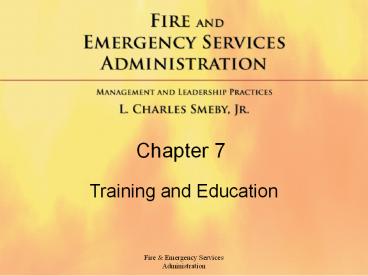Training and Education - PowerPoint PPT Presentation
Title:
Training and Education
Description:
They provide a margin of safety. ... Staffing Company Officer Education and Training Either ... requires 24 hours of training per year on structural firefighting. – PowerPoint PPT presentation
Number of Views:4297
Avg rating:3.0/5.0
Title: Training and Education
1
Chapter 7
- Training and Education
2
Overview
- Administrators are responsible for efficient and
effective emergency operations. - There are no shortcuts to having members who are
well trained. - Members should be trained, beginning with an
intense recruit school, and should receive
updated training regularly.
3
In-service Training
- Must be high priority.
- Use NFPA 1500 as a template.
- Training should involve teams when doing
fireground operations. - The best retention comes when applying the
knowledge to an actual incident or training
exercise.
4
Higher Education
- Most programs are offered at community colleges,
with a few universities offering bachelors
degrees. - Most Bachelor degree programs are Internet based.
- This method requires great self-discipline.
- When researching programs, make sure they fit
your needs. - Is the college fully accredited?
- Will the offered courses transfer to other
schools? - What is the official degree title?
5
Professional Development
- Many excellent seminars and conferences with
outside experts exist. - Members attending outside programs should be
required to present the knowledge to their
department. - Be selectivemany presentations are not founded
on knowledge that would stand up to peer review. - Training and professional development is a
never-ending process.
6
Recertification
- Currently there are no recertification or
continuing education requirements. - Each department should create a standard training
program and schedule.
7
Standard Operating Procedures
- SOPs are needed due to the nature of emergency
services. - Split-second decisions must be made by first
arriving companies. - They provide a margin of safety.
- They can have a huge effect on the final outcome.
- For consistency and reliability, they should be
followed with few exceptions. - Must be reviewed and practiced frequently.
8
Developing SOPs
- Developing SOPs can be a very contentious
process. - Best done on a regional basis.
- Dont reinvent the wheel!
- Always include the option for the company officer
to deviate at his or her professional judgment. - Include a critique process for each deviation.
9
Regional Approaches to Training
- Greatest need is for multi-company drills and
entry-level Fire Fighter I and II. - Many smaller departments struggle with finding
the opportunity to train on even a typical house
fire that needs multiple companies. - For more specialized training, regional
cooperative approaches are very effective and
affordable.
10
Hazardous Materials Teams
- Hazardous materials emergencies have required a
rethinking of many of the traditional approaches. - In the past two decades there has been a huge
increase in the number of hazardous materials
teams in the public sector. - Many communities have found that these
specialized teams are used rarely, if at all. - With so few calls, there is little chance to test
the teams training and increase their experience.
11
Initial Fire Attack Training Goals
- NFPA 1410, Standard on Training for Initial
Emergency Scene Operations, outlines typical
fireground evolutions and recommended completion
times. - If times are inadequate, evaluate the following
- Frequency of training sessions
- SOPs
- Staffing
12
Company Officer Education and Training
- Either a lieutenant, captain, or a chief in a
one- or two-station department - Based on the NFPA professional qualifications
standards for Fire Officer I and II
13
Chief Officer Education
- Chief officer should look at formal education as
a tool to be effective at his or her job. - Many other agency heads will have at least a
bachelors degree. - Bachelors degree should be in relevant major
such as fire science, management, or
administration or public administration or policy.
14
Quality Service
- Training and education are crucial for quality
service. - Higher education is the key to the door of
opportunity both personally and professionally. - Education puts the fire officer on equal ground
with contemporaries and elected or appointed
officials. - Education will give the fire officer the tools
needed to be a change agent.

